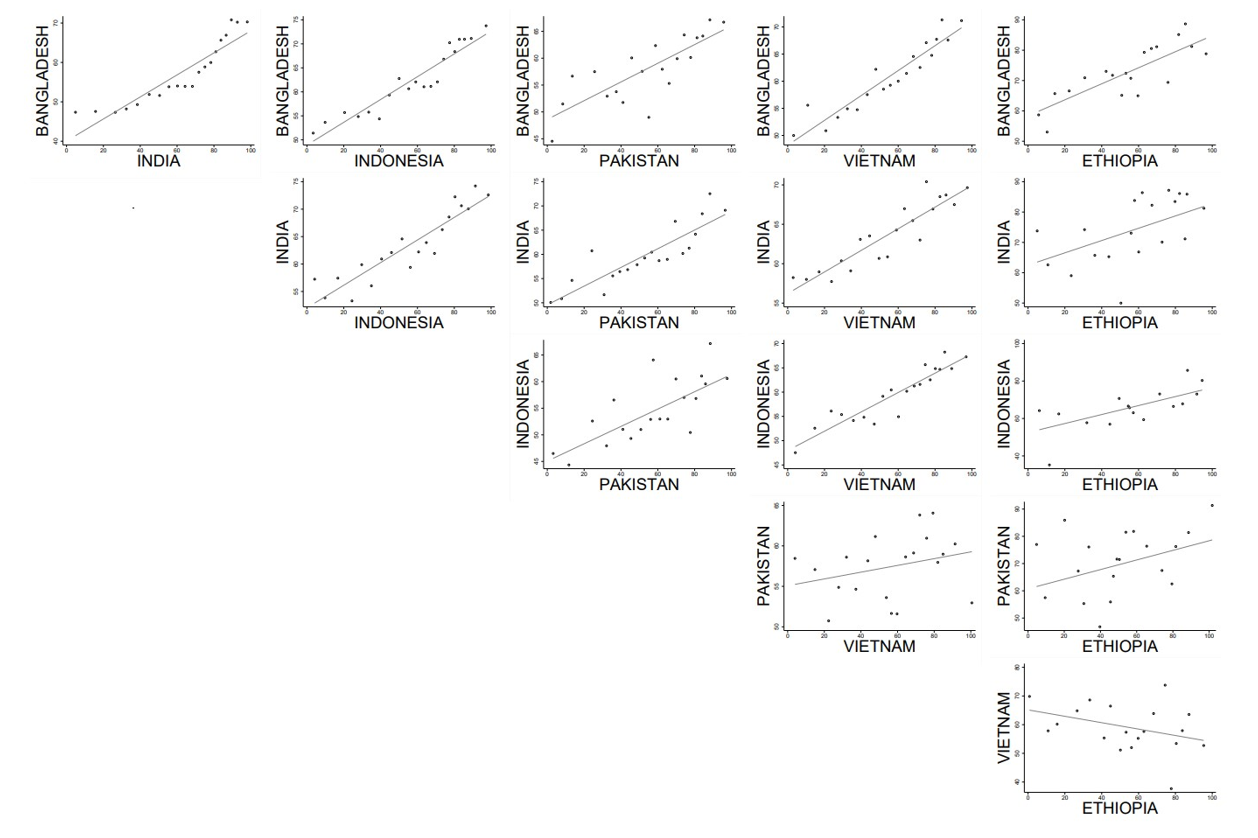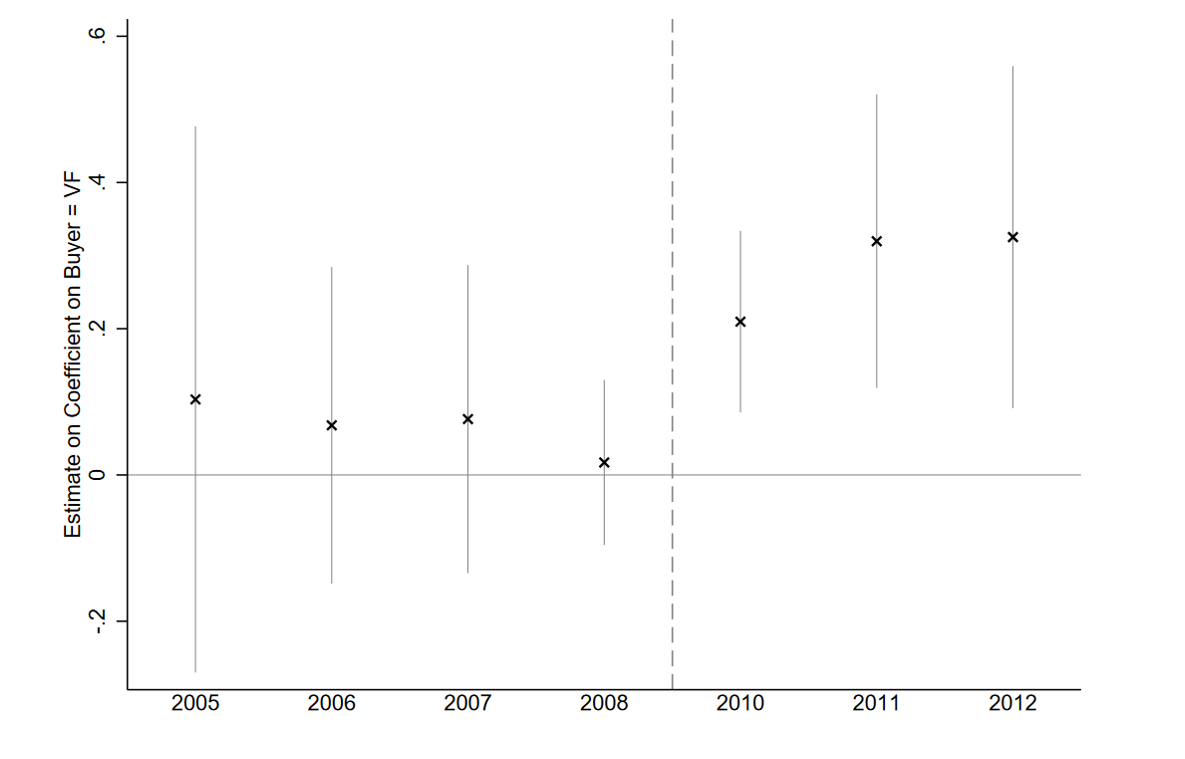
The sourcing strategies of global buyers can have profound implications for suppliers in low-income countries. Using novel data, research in the garment sector reveals how global buyers differ in their approach to sourcing and why that matters for suppliers’ margins.
A firm’s approach to sourcing is a critical strategic decision. The literature has described two polar sourcing strategies (Taylor and Wiggins 1997). At one extreme, the buyer allocates short-term orders to the lowest bidders keeping suppliers at arm’s length, avoiding any type of commitment, and bearing the costs of suppliers’ non-performance. Purchases are then spread among multiple suppliers in a constant quest to keep prices as low as possible. Let us label this system “spot sourcing”. At the other extreme, the buyer allocates orders to a few suppliers with whom it develops long-term relationships. These relationships are used to incentivise behaviour that might otherwise be difficult to contract upon. Let us label this system “relational sourcing”.
The sourcing strategy is a key driver of a company’s performance. For example, in the late 20th century, the relational approach adopted by Japanese car manufacturers in contrast to the spot approach of their American counterparts was heralded as a key driver of the success of the former and the decline of the latter (e.g., Helper and Sako 1997). Since the organisation of sourcing must be coordinated with internal structures and management practices (Milgrom and Roberts 1990, 1995), firms – even those competing within narrow industries – end up with different approaches to sourcing (Helper and Henderson 2014).
But do buyers’ sourcing strategies matter for suppliers, particularly those in low-income countries? Do suppliers earn higher markups from relational buyers? If so, are buyers’ choices of sourcing socially efficient, or is there scope for policy intervention? Answering these questions is important—particularly in developing countries, where buyers can act as potent vehicles for upgrading (World Bank 2020). Empirical evidence, however, is hard to come by because it is difficult to quantify buyers’ approaches to sourcing and because margins are notoriously difficult to estimate.
In our research (Cajal-Grossi, Machiavello, and Noguera 2023), we leverage detailed data on Bangladeshi garment manufacturers to test the claim that relational sourcing yields higher margins for suppliers. The key finding is illustrated in Figure 1: a given supplier earns approximately 2.5% higher prices for an identical order delivered to a relational buyer relative to a spot buyer. This effect translates into a substantial increase in margins and value-added in the exporting country.
Figure 1: Differences in suppliers’ margins between spot and relational sourcing

Sourcing garments
The production of garments has played a critical role in the early phases of export-oriented industrialisation, most recently in East Asia (Gereffi 1999). The sector provides a training ground for developing countries to learn modern manufacturing management systems and has been a powerful engine for women’s emancipation and social change (Macchiavello et al. 2020, Heath and Mubarak 2015, Atkin 2016). In Bangladesh, garments account for over 80% of exports and 12% of GDP and the industry employs millions of workers, mostly women.
How are garments sourced? Building on the intuition that relational buyers concentrate their sourcing among a small number of suppliers suggests that a buyer’s sourcing strategy can be proxied by using the ratio of the number of suppliers relative to the overall sourcing volume. This measure can be easily computed from custom records for each buyer sourcing different products in different countries.
So, what do garment buyers sourcing strategies look like? Transaction cost economics (Williamson 1975, 1985) predicts that the choice of governance form – in our case, the choice between spot sourcing and relational sourcing – is driven by the contractual difficulties associated with the transaction. In our context, products that are more differentiated (Rauch 1999), that have more complex fashion cycles (Woodruff 2002), or that are sourced from countries in which contracts are harder to enforce (Antras and Foley 2015) should be more likely to be sourced relationally.
Figure 2, however, reveals an intriguing fact: a given buyer sources very similarly across both countries and product categories. For example, the Swedish fast-fashion giant H&M appears to source relationally, regardless of whether they are importing women’s shirts from China, or men’s trousers from Bangladesh. In contrast, a different buyer tends to source those same products from the same origins through spot sourcing. This suggests that buyers' sourcing behaviour is largely driven by buyer-level capabilities, rather than by adaptation to local sourcing conditions.
These observations suggest proxying a buyer sourcing strategy with the (weighted) average ratio of the number of suppliers relative to sourced volumes across product categories and countries from which the buyer sources. This yields a ranking of buyers in terms of how relational their sourcing is. The resulting ranking is well in line with more qualitative accounts taken from industry publications and case studies.
Figure 2: Correlations in buyers' sourcing strategies across countries

Evidence of the benefits of relational sourcing to sellers
From the point of view of the supplier, does it matter if the buyer adopts a relational or a spot approach to sourcing? A key implication of the theory is that the margins earned on production orders for different buyers should differ. In general, it is difficult to test this hypothesis because even if customs data record the price that the buyer pays to the supplier for a given order, the costs incurred by the supplier to produce that order are unknown. We, however, take advantage of two novel aspects of the data. First, because of the trade regime in place, the customs records allow to link to a given export order the amount and price of fabric utilised to produce that order. Second, detailed internal records collected to evaluate training programmes in several factories (Macchiavello et al. 2015, 2020) also allow us to match workers and their wages to orders produced for specific buyers. Since fabric and labour are the two main variable inputs in the production of garments, this information goes a long way to measure cost differences across orders produced by the same exporter, in the same product category, for different buyers.
In the cross-section, estimates reveal 10-20% higher supplier margins when supplying a relational buyer, such as The Gap, relative to a buyer with the average sourcing strategy. This difference is entirely driven by relational buyers paying higher prices for otherwise identical orders that use the same amount and type of variable inputs. The finding is confirmed by a natural experiment. VF – a brand conglomerate behind household names such as The North Face and Timberland -- pivoted its global sourcing strategy from spot to relational around 2010, in the middle of the sample period. In Bangladesh, this shift was associated with a profound restructuring of the supply chain: VF would source larger, and more stable, volumes from fewer suppliers. Figure 3 shows how, conditional on remaining in VF’s supply chain, suppliers’ margins increased for orders produced for VF relative to orders produced for other buyers.
Figure 3: Suppliers’ margins around VF’s pivot towards relational sourcing

Policy implications
Do these results matter for policy? They do. First, they have policy implications for export promotion agencies, particularly in developing countries. International buyers’ sourcing strategies are a potentially important dimension of upgrading for exporting firms in developing countries (e.g., Egan and Mody, 1992). Not just what, and where it, is exported matter for upgrading: to whom it is exported matters too. Export promotion agencies might want to target programmes to assist exporters in establishing relationships with relational buyers.
Buyers’ sourcing strategies are likely important for other forms of upgrading, beyond domestic value addition. Relational contracting at the export gate can be leveraged to improve the efficiency, equity, and sustainability of global supply chains (Boudreau et al. 2023). Macchiavello and Miquel-Florensa (2019) find that a relational buyer paid higher margins to the exporter but also increased price premia to coffee farmers that supply the exporter. In apparel, there is some evidence that relationships at the export gate can be used to improve compliance with suppliers’ codes of conduct (e.g. Amengual and Distelhorst 2019) and labour safety regulations (Boudreau 2023). Relational buyers might also contribute to supply chain resilience (Macchiavello and Morjaria 2015, Blouin and Macchiavello 2019, Cajal-Grossi et al. 2023).
More generally, sourcing strategies are chosen in response to contractual complexities and market failures (Macchiavello 2022). There is thus no guarantee that buyers' voluntary choices of sourcing strategies yield a socially efficient outcome. Indeed, policymakers are increasingly active in regulating environmental and social standards in supply chains (e.g. the Dodd Frank Act’s provision on conflict minerals, the EU Regulation on Deforestation-free Products). These initiatives highlight the importance of better understanding the adoption, and impact, of different sourcing strategies in global value chains.
References
Amengual, M and G Distelhorst (2019), “Can Sourcing Help Enforce Global Labor Standards? Evidence from the Gap Inc Supply Chain,” mimeo.
Antràs, P and F Foley (2015), “Poultry in Motion: A Study of International Trade Finance Practices”, Journal of Political Economy, 123(4): 853–901.
Atkin, D (2016), “Endogenous Skill Acquisition and Export Manufacturing in Mexico”, American Economic Review, 106(8): 2046-2085.
Blouin, A and R Macchiavello (2019), “Strategic Default in the International Coffee Market," The Quarterly Journal of Economics, 134(2): 895-951.
Boudreau, L, J Cajal-Grossi, and R Macchiavello (forthcoming), “Global Value Chains in Developing Countries: a Relational Perspective from Coffee and Garments”, Journal of Economic Perspectives.
Cajal-Grossi, J, D Del Prete, and R Macchiavello (forthcoming), “Sourcing Strategies and Resilience of GVCs in Garments,” International Journal of Industrial Organization.
Cajal-Grossi, J, R Macchiavello, and G Noguera (2023), “Buyers’ Sourcing Strategies and Suppliers’ Markups in Bangladeshi Garments”, The Quarterly Journal of Economics, 138(4): 2391–2450.
Egan, M L and A Mody (1992), “Buyer-Seller Links in Export Development,” World Development, 20 (3): 321–334.
Gereffi, G (1999), “International Trade and Industrial Upgrading in the Apparel Commodity Chain,” Journal of International Economics, 48: 37–70.
Heath, R and A Mobarak (2015), "Manufacturing growth and the lives of Bangladeshi women," Journal of Development Economics, 115(C): 1-15.
Helper, S and R Henderson (2014), “Management Practices, Relational Contracts, and the Decline of General Motors,” Journal of Economic Perspectives, 28(1): 49–72.
Helper, S and M Sako (1997), “Supplier Relations in Japan and the United States: Are They Converging?,” MIT-Japan Program.
Macchiavello, R (2022), “Relational Contracts and Development," Annual Review of Economics, 14: 337-362.
Macchiavello, R and A Morjaria (2015), “The Value of Relationships: Evidence from a Supply Shock to Kenyan Rose Exports," American Economic Review, 105(9): 2911-45.
Macchiavello, R and C Woodruff (2014), “Supervisory Management and Productivity Dispersion in the Bangladeshi Garment Sector,” Technical Report 971, Society for Economic Dynamics.
Macchiavello, R, A Menzel, A Rabbani, and C Woodruff (2020), “Challenges of change: An experiment promoting women to managerial roles in the Bangladeshi garment sector,” Technical Report, National Bureau of Economic Research.
Macchiavello, R and J Miquel-Florensa (2019), “Buyer-Driven Upgrading in GVCs: The Sustainable Quality Program in Colombia”, mimeo.
Milgrom, P and J Roberts (1990), “The economics of modern manufacturing: Technology, strategy, and organization,” American Economic Review: 511–528.
Milgrom, P and J Roberts (1995), “Complementarities and fit strategy, structure, and organizational change in manufacturing,” Journal of Accounting and Economics, 19(2-3): 179–208.
Rauch, J E (1999), “Networks versus markets in international trade,” Journal of international Economics, 48(1): 7–35.
Taylor, C R and S N Wiggins (1997), “Competition or compensation: Supplier incentives under the American and Japanese subcontracting systems,” American Economic Review: 598–618.
Williamson, O E (1975), “Markets and hierarchies: analysis and antitrust implications: a study in the economics of internal organization,” University of Illinois at Urbana-Champaign’s Academy for Entrepreneurial Leadership: Historical Research Reference in Entrepreneurship.
Williamson, O E (1985), The Economic Institutions of Capitalism: Firms, Markets, Relational Contracting, New York: Free Press.
World Bank (2020), World Development Report 2020: Trading for Development in the Age of Global Value Chains, International Bank for Reconstruction and Development, The World Bank.
Woodruff, C (2002), “Non-contractible investments and vertical integration in the Mexican footwear industry,” International Journal of Industrial Organization, 20(8): 1197–1224.



